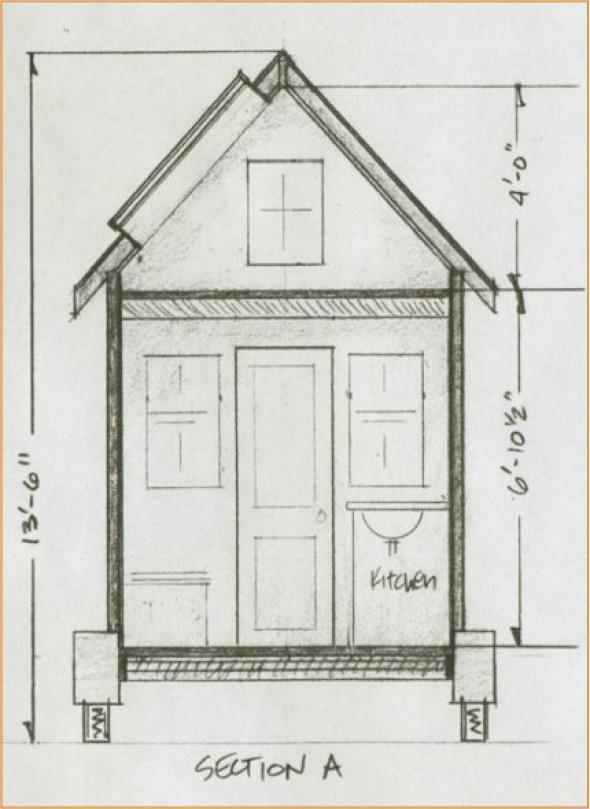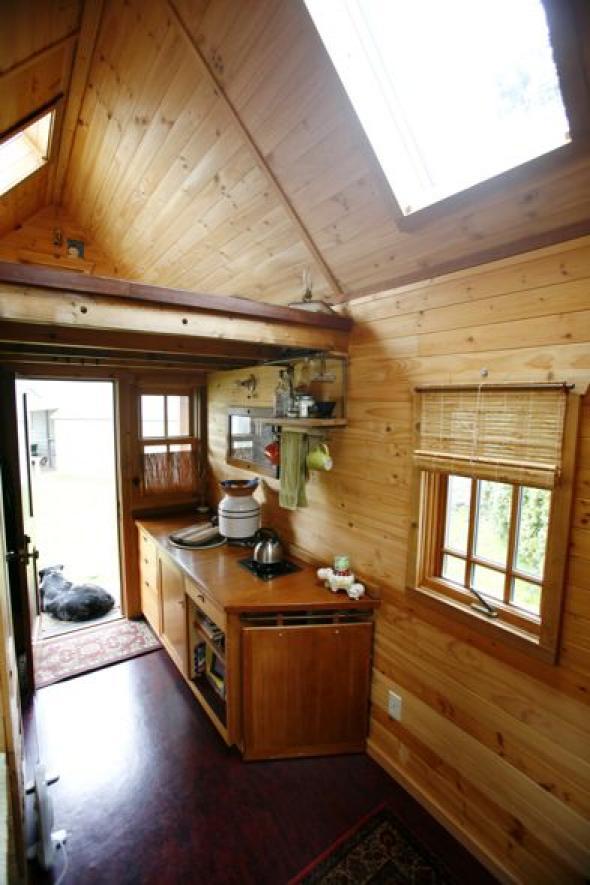Dee Williams is an Olympia, Washington-based teacher, designer, woodworker, and sustainability advocate who owns Portland Alternative Dwellings, where she designs and builds tiny houses. Here at the Eye, Williams shares an excerpt adapted from The Big Tiny, her new memoir published by Blue Rider Press. The book details her reflections on living in a portable 84-square-foot house parked in a friend’s backyard that she built herself after a health crisis–inspired epiphany compelled her to simplify her life.
Now that I had my trailer on order, I needed to fully flesh out the design. I took the plans and manipulated them, switching the location of the kitchen and bathroom, the sleeping loft and living room; envisioning what it would feel like to wake up in a space the size of my backcountry tent, and which direction I would face while sitting on the toilet. I wanted to design the house around my body and my needs, instead of following the pattern that I’d fallen into in my big house: picking paint colors and finishing the woodwork with some future owner and salability in mind. This was going to be my house.
I started examining the way I draped clothes over the chair in my bedroom as I undressed at night, and how I automatically reached for the light switch just below shoulder height on the right, no matter what room or building I entered. I noticed how much space I needed to chop an onion or make a peanut butter sandwich, the height of my existing kitchen counters, the cabinets, and chairs. I measured the height of the toilet, the depth of my closet, and the amount of room my torso consumed when I sat up in bed—all so I could design a house that fit my body and my needs, instead of someone else’s. I felt like Jane Goodall, observing my behavior and wondering at the mystery of why I always brushed my teeth starting with my right bottom molars, why I always double-checked that the coffeepot was unplugged before I left for work in the morning, and why I always leaned forward with my left ear cocked when trying to define the odd sounds that I heard outside the window late at night.

Courtesy of Dee Williams
The more I took note of how my body and brain clicked along through the day, the more I realized that I spent a considerable amount of time banging around with a brain full of chatter; a rush of things to do, bills to pay, telephone calls, text messages, emails, worrying about my job or my looks, my boobs or my ass; I rushed from thing to thing, multitasking, triple-timing, hoping to cover all the bases, avoiding anything that might disrupt the schedule or routine. At times, I was so caught up in the tempo and pattern, the predictable tap tap tap of each day, that there was no time to notice the neighbors had moved out, the wind was sneaking in from the north, the sun was shifting on its axis, and tonight the moon would look like the inside of an enormous cereal bowl. I wondered when I had become a person who noticed so little. I had no idea that the distance from the floor to the top of my knee was 24 inches, which seemed to explain why I was always popping it on my car bumper.
Things had changed for me after I landed in the hospital. I truly seemed to be seeing the world in a new way, but I still needed to challenge myself to try to tune in, to notice the connections between what things were (the toilet paper holder, light switch, doorknob) and how they connected to me, so suddenly I understood how the height of the bathtub made it easy to get in and out of the shower, and the way the handle of the front door was low enough to grasp even when my arms were full of groceries.
The overall size of my house could be no taller than 13½ feet from the pavement to the peak, and no wider than the wheel wells of the trailer (8½ feet). That meant I spent days and hours trying to sort through the pros and cons of a lower ceiling in the kitchen to accommodate a taller ceiling in the loft, and figure out how could I cram everything I loved into a house the size of an area rug.

Courtesy of Dee Williams
The bathroom and kitchen seemed to absorb the greatest amount of time, leaving me wringing my hands while I considered all the things I wanted (a small oven, three burners, pantry, refrigerator, freezer, food prep area, cupboards for dishes, drawers for tea towels, silverware, pots, pans, toaster, a shower, toilet, bathroom sink, and a place to store all my grooming tools and “boo-boo dust,” as my sister and I called our lotions and potions). But there was only so much space. I made of a list of pros and cons, and argued with myself, trying to imagine what the future me might want and what she would say about the old me’s choices.
Ultimately, because of the tight quarters, I settled on imagining what would be necessary if I was staying in a remote cabin, and developed a sort of glorified list of necessities.
I landed on a decision to install a small one-burner stove called the Princess. It was a marine stove suitable for the types of meals I regularly cooked: small, elegant, and poised for something more … just like a princess. I had to be brutally honest with myself, I rarely used my existing four-burner stove and oven, an appliance that was labeled “Magic Chef,” a mismatch for my particular flair, which was opening up soup cans and pouring the contents into a waiting pot. The Princess left room for the ceramic sink that I’d found in the crawl space of my big house, a beautiful hand-thrown bowl fitted with a tiny pipe that instead of draining to the city sewer would dribble into a giant Ball jar to be dumped in the garden. At the local RV store, I tried on the various bathroom setups, units that allowed you to sit on the toilet while taking a shower, or to crouch in a baby bathtub with your knees near your ears while you sipped wine and enjoyed a nice tub soak. These units were almost exclusively made out of fiberglass cloth impregnated with styrene (a possibly carcinogenic chemical that smells to high heaven). An outdoor shower and compost toilet seemed like my only option.

Courtesy of Dee Williams
I agonized over which should take up more space inside my postage stamp of a house: a refrigerator large enough to hold a week’s worth of food, beer, and half-and-half, or a composting toilet that according to the pamphlet was too big to fit in the trunk of my car? I chose neither. I shrank the refrigerator down to the size of an undercounter icebox, and decided to venture forward with a bucket composter—a system that required me to manage the waste along with my organic kitchen scraps in a compost barrel outside the house (a decision I made only after reading a hefty book called The Humanure Handbook, a really great manual that walked through the various diseases, germs, bugs, and social phobias we all carry when it comes to our poop).
The only major unknown was the shower. There wasn’t any room for it inside the house; there wasn’t an easy way to heat up the water, deliver it to a showerhead, and dispose of it safely. I was stuck, and after staying up till three in the morning one night, thumbing through the Lehman’s catalog, a book that included photos of all the ways the Amish and off-grid settlers bathe, I decided to buy a membership to a gym. I figured I could get a membership at one of those big national gyms, so wherever I went from town to town, I could shower as much as I wanted.

Courtesy of Betty Udesen
All of this consternation—trying to sort through how much I could bend without breaking when it came to modern conveniences—left me one part freaked out about living in the little house, and one part over-the-top excited.
It also begged me to ask a thousand times a day: What am I doing? What is the point? And every time, something deep inside me would shoosh me and say: “Because you can! That’s the point of all of this. You can do this! You can build a simple, kind house … nothing fancy, no big deal … just a little house that will fit you more or less.”
After a month or so of playing around with layouts, after examining all my little quirks and patterns, I came up with a floor plan for the little house. I invited friends to dinner, greeted them at the door, masking tape in hand, and showed them the blueprint I’d taped out on the living room rug. “This will be the kitchen,” I offered. “And this will be the bathroom,” I explained, shifting my weight to the right. “The sleeping loft will be above, and here,” I said taking two steps forward, “is the great room.” I stood on the leeward end of the rug and threw my hands over my head like pom-poms.

Courtesy of Dee Williams
They stared at me with a mixture of concern and curiosity.
“Umm,” one friend asked, “doesn’t that make the great room [she said it with little finger quotes] the size of the dining room table?” She wanted to know if I was joking.
It wasn’t a joke, but I had to admit I was curious about whether or not it could be done. I felt that it could in the same way I was certain it would be fun to try climbing Mount Adams, Mount St. Helens, and Mount Hood all in a single weekend. Of course it was possible!
As we ate dinner sitting on the living room rug, my friends joked about how I could vacuum the tiny house with a tiny Dustbuster and could pull it through a car wash when the windows needed cleaning. After a few beers, we played a game like Twister, tumbling over each other while standing on the rug, seeing if we could reach for a pillow off the imaginary living room couch while sitting on the toilet, or open the front door and reach for a coffee cup on the far side of the kitchen without ever stepping foot in the house. Before everyone left that night, I gave each of them something pulled randomly from the kitchen: a bottle opener, a wineglass, a ladle, or a set of pot holders that looked like chicken heads.
The downsizing had begun.
Adapted and reprinted with permission from Blue Rider Press, copyright 2014.

Courtesy of Blue Rider Press
